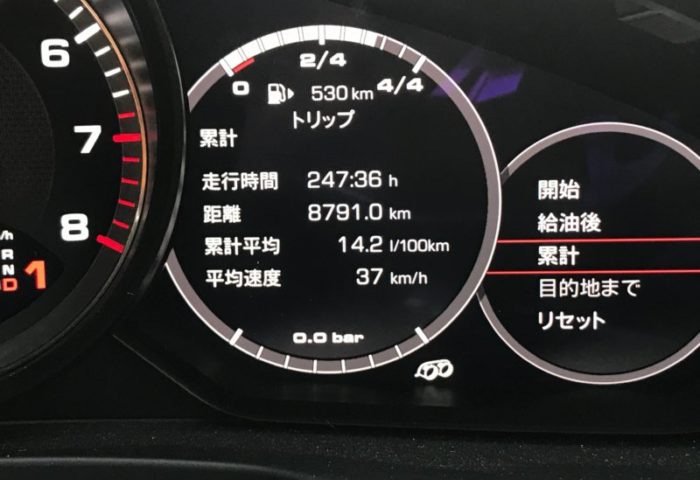Actual Cumulative Fuel Efficiency of the Porsche Panamera After 8 Months and About 8,700 km
公開日:2018.06.15

When to Wash the Panamera
Alright, tomorrow we’re finally heading to the Porsche Experience Day at Fuji Speedway! So, for the past few days, my husband and I have been debating when to wash the Panamera while checking the weather forecast.
Husband: “The best would be to wash it on Friday, but since it’s supposed to rain on Friday, maybe wash it on Thursday instead.”
Me: “But on Friday, we’ll be using the car for our daughter’s dentist appointment and daycare, so it’ll get dirty again.”
Husband: “But since the rain is forecasted for after noon on Friday, maybe I should drive the Panamera to work on Friday, and if it pours on the way back, it might actually get cleaner. Although, the wheels might get dirty again.”
Me: “But since Saturday is rainy anyway, it’ll just get dirty again no matter what.”
After all that, my husband ended up driving the Panamera to work yesterday and washed it by hand on the way home.
Three Golden Rules for Driving Today
That said, since it was raining this morning, my husband reminded me of a few things before leaving for work:
Listen carefully, for today’s driving:
① Keep plenty of distance from the car ahead to avoid splashes
② Always avoid puddles
③ Drive slowly to minimize water splashes
If you follow these, the wheels won’t get dirty easily, and if the body gets a bit dirty, it’s manageable!
…O-okay.
I followed his instructions, so for now, the wheels are still clean (laughs).
What’s the Panamera’s Cumulative Fuel Efficiency Since Delivery?
Before heading to Fuji, I decided to check the current fuel efficiency and mileage of the Panamera. Switching the meter display to “cumulative” shows the total fuel efficiency since delivery (which I hadn’t known until now). According to that:
• Delivery date: October 12, 2017 (about 8 months ago)
• Driving time: 247:36 hours
• Distance: 8,791.0 km
• Cumulative average: 14.2 l/100 km
• Average speed: 37 km/h
Here’s a tricky part… seeing this fuel efficiency, you might want to jump for joy thinking “14 km/l average fuel efficiency? That’s amazing!” — I used to think that too. But,
Our Panamera’s meter is set by my husband to display “liters used per 100 km (l/100 km)” instead of “kilometers per liter (km/l)” (which is common in Europe). When recalculated into the Japanese standard, it’s actually…
7.0 km/l.
Not exactly great (-_-). But according to the catalog:
• Overall average: 10.6 km/l (9.4 – 9.3 l/100 km)
• City driving: 7.7 km/l (12.9 – 12.8 l/100 km)
• 100 km/h cruising: 13.6 km/l (7.3 – 7.2 l/100 km)
*Mountain roads: 5.3 km/l → Not in the catalog, but from Car Graphic’s research
Considering that I mostly drive in city traffic with lots of stoplights and congestion, and my husband often drives spiritedly on mountain roads like the Royu Driveway, this figure seems reasonable.
The Panamera Turbo’s Fuel Efficiency Isn’t That Bad
When I told my husband, “The Panamera Turbo’s fuel efficiency is really bad!” he said:
But for a 2-ton giant with a 4L V8 twin-turbo (550 hp), this fuel efficiency is actually pretty good compared to other manufacturers.
I see. So I decided to compare the Panamera Turbo’s fuel efficiency with similar engine models from Mercedes-Benz, Lexus, and BMW. Since I wanted real-world data rather than catalog numbers, I looked up test drives and personal blogs from automotive media.
Here are the results:
① Mercedes-Benz S63 AMG 4MATIC Long (5.5L V8 twin-turbo engine)
8.9 km/l
→ Reference article: Mercedes-Benz S63 AMG 4MATIC Long (4WD/7AT) [Test Drive]
② Lexus LC500 (5.0L V8 naturally aspirated engine)
Average: 9.0 km/l, City: 6.2 km/l, Highway: 11.8 km/l
→ Reference article: Fuel Efficiency Report on Lexus LC500 Test Drive (1/2)
③ BMW M5 (4.4L V8 twin-turbo engine)
Average: 6.0 km/l, City: 4.4 km/l, Highway: 7.4 km/l
→ Reference article: BMW M5 (F10) Specs, Price, and Review
…
Hmm… what do you think? (*_*) (laughs)
I was hoping to find that “the Panamera Turbo has better fuel efficiency than other brands!”, but honestly, I can’t see a clear difference. In fact, some other brands have better numbers.
To be honest, I’m not very familiar with cars from manufacturers other than Porsche, so I’m not even sure if this was the right comparison (lol).
Porsche’s Real-World Numbers Often Beat the Catalog
One thing I can say for sure: when you actually drive a Porsche, you almost always get better numbers than the catalog states. Car Graphic once did a thorough test, and even under pretty bad conditions, the results were better than the catalog.
→ [Reference article] Are Porsche’s Catalog Numbers Really Accurate? Testing the Panamera in Car Graphic Magazine
So I’ll end today’s article by firmly stating that Porsche is a very trustworthy manufacturer.
このブログが気に入ったらフォローしてね!


Comment ( 0 )
Trackbacks are closed.
No comments yet.